It seems like every other email I receive is related to Coronavirus. Then there are the ones that are completely unrelated, for example, business as usual. In both cases, there are potential issues. For staters, it’s not business as usual. Brands that have taken up automated processes are particularly at risk at this point. I’d like to provide a couple of good and a couple of bad ideas to inspire us to communicate better during this crisis.
Bad ideas
Don’t call your customers a community if it ain’t
I literally laughed out loud when I received a couple of emails from companies on whose mailing list I have remained, more or less quietly over the years. They started off the message: “Dear XYZ Community.” For example, from Thom Browne (received Mar 18 2020). I’ve bought two pairs of their glasses. Love them. However, I feel in no way connected to the company. This is the first non commercial message I’ve ever received from them.
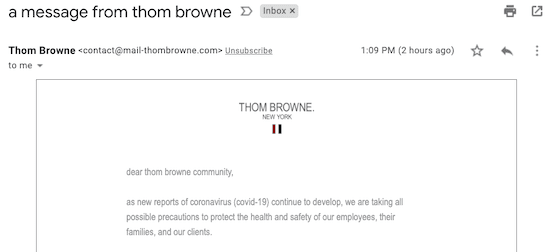
This Thom Browne message isn’t the only “community” outreach I have received. The issue is that you think (or wish) you’ve got a community, but you’ve done nothing to foster it in the past. It might exist inside the company, but in the case of Thom Browne, definitely not out here. You can’t just start up cold turkey.
Watch out for tone deafness
Some of you will have heard that countries are on lockdown. Others seemingly have not heard the news. That means, if you are referring to travel, you ought to be rather mindful. If you’ve buffered your email message and programmed out your monthly communications, now would be a good time to urgently review them. Take Shu Uemura’s unwise commercial blast sent on Mar 18 2020 at 1pm: “complimentary travel dry shampoo“.
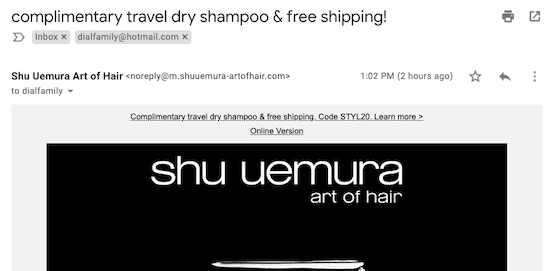
If you’ve been using marketing automation tools, you’d better check on what you’ve got in the buffer. Make sure that the automated messages you’ve set in place aren’t tone deaf. It’s worth reviewing them to make sure that every communication is relevant.
Good ideas
Choose the right medium
How many emails have you received from a company saying “we care about our customers and employees” and “please wash your hands.” Dry, institutional and patently impersonal. The vast majority of these messages aren’t ‘wrong,’ but at best they’re a missed opportunity. At worst, they are a waste of time and resources. I’d highlight this message from American Airlines that has two things going for it: (a) it’s in video format; (b) it is from a real human being, expressing himself (albeit somewhat drily and clearly using a teleprompter). To his credit, it appears to be done in one take. And he’s got a very reassuring voice. Click on the image to go to the page with the video.

Be valuable

I’m a big fan of Jay Baer’s book, Youtility. In it, Jay talks about the different ways a brand can orchestrate content by bringing utility to and being valuable for your customers. In these trying times where sales are dropping, there’s always a temptation to slide in a sales pitch. Among other YOUSEFUL initiatives, I salute the efforts by LVMH CEO, Bernard Arnault, who quickly organized its Christian Dior factory to convert to hand sanitizer production within 72 hours. They are set to donate 12 tonnes of the LVMH branded hand sanitizing gel to 39 Parisian hospitals … by the end of this week. Love the CD pump! Read more in the FT.
Another good example is from the Business of Fashion. I’ve been a subscriber of theirs for several years. They sent out a request to hear my thoughts, which is directly in line with its mission to open, inform and connect the global fashion community. It’s particularly appropriate when you know how badly the fashion industry has been affected, given the density of producers in northern Italy and China. Now to see what they do with that information!
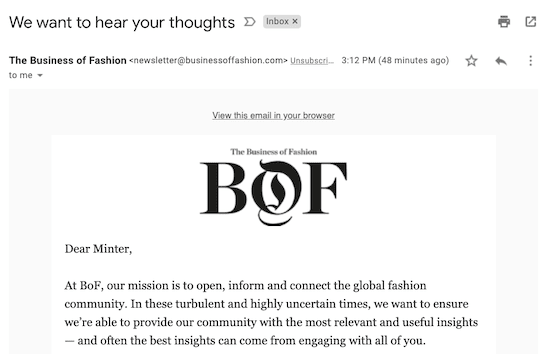
Encourage others & reach out
As a speaker and consultant whose work has all but dried up, I’ve been impressed with certain individuals and small organizations who’ve stepped to create support groups and/or help sessions to deal with this situation. I highlight Alan Stevens, a brilliant media coach, who set up a Facebook group on Remote Speaking and my friend Katz Kiely, founder of WeAreBeep, on setting up a “Little Less Talk A Little More Action” brainstorm (that I wasn’t able to attend). I imagine how some bigger brands could think and act the same way. How can brands encourage others, reach out and tangibly help their customers and community?
In the realm of sending out the WRONG message, here’s one last poor example. I tag BLOW Ltd that has seen fit on March 19th 2020 (today!) to encourage people in London to beat the system, inciting their customers to get their toes and nails polished before the whole city goes on total lockdown. Really? Aside from anything, it smacks of desperation. Now is a great time to evaluate your true ethical backbone.

4 unordinary tips for communicating in times of crisis
Here are four unordinary tips to communicate effectively in a time of crisis. Would love to have your thoughts and comments!
- The headline. Pay particular attention to the headline or title of your message. With messages intended for a wider circulation, I suggest having your title reviewed by a fairly diverse group of people who have license to push back if there are insensitivities.
- What’s in it for the receiver? Make sure you’re plugged in to your community and think through the benefits for the receiver. Bring utility, value or even appropriate entertainment providing it’s in touch with your de facto brand values and community.
- Bear in mind your employees, first. As much as you need to keep the business going, when you communicate externally (e.g. to clients and other stakeholders), your employees will be looking at those messages with an eagle eye. Be careful not to conflate generosity and kindness with discount offers. It’s a good opportunity to make your employees feel proud.
- Flex your empathic muscle. Make sure that you are stepping out of your small echo chamber to engage with others outside your regular circle. Ask them questions. Be prepared to listen deeply. Permit emotions, including your own. Show genuine vulnerability. Know that because you see things one way, doesn’t mean everyone else does, too!
A special bonus tip
In this new world order that has been with us well before the Coronavirus, one of the big challenges is and will continue to be cutting through the noise. A recent infographic on the amount of media coverage and mentions of this Covid-19 #Coronavirus shows just how gargantuan this crisis feels compared to past pandemics. If you want to contribute to the ocean of messages, make sure you’re saying something useful and valuable. Tap into your real mission. Make it personal and meaningful. I’d invite you to ask yourself before you hit the SEND button: how will this message make its receivers feel better?
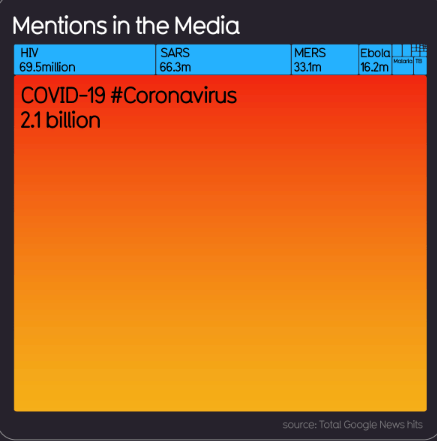
Please give me your thoughts and comments. I’d be very keen to hear about other examples of brands doing good communications during this time of crisis!

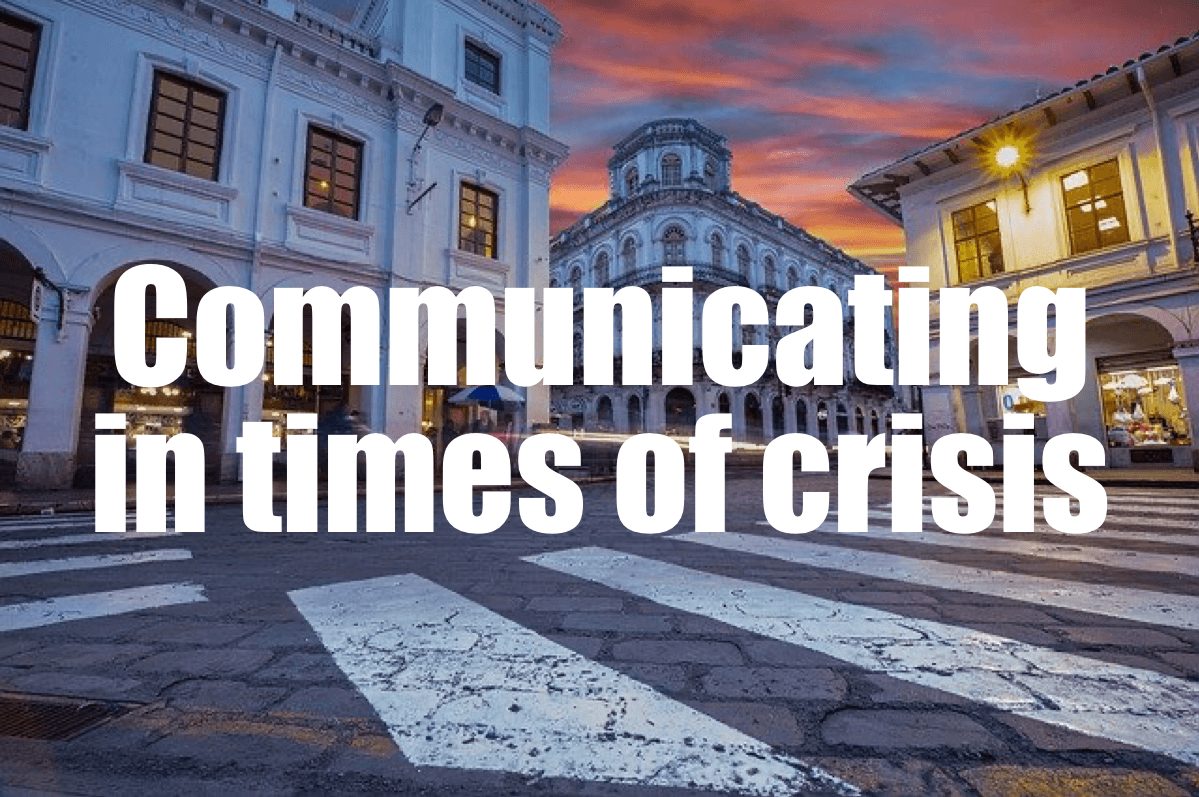










Some very good advice Minter, thank you.
I also would like to highlight much smaller companies like Atelier Tuffery in France producing protective masks for medical staff for free, Brewdog in the UK producing hand sanitisers to give away for free. There are many more like these and they deserve much credit because they don’t have the economic power of LVMH. Credit is due also to all the media companies and cultural organisations that are making their programmes, shows, exhibitions free to access online.
Overall, the crisis we are going through is a rare opportunity for companies to showcase solidarity and humanity. And I believe the ones that are getting it wrong may pay a hefty price for a long time to come!
Love that you are highlighting other positive initiatives Delphine. When the dust settles, hopefully the ones who conducted themselves honorably will be duly rewarded! 🙂
Great advice Minter. Have to say 50% of advertising looks completely out of place at the moment. Just contributes to the ‘zombie apocalypse’ feeling – the brand owners need to use a bit more imagination.
It seems one can’t view any signalling / communications — even conversations — these days but through the filter of the current context, Chris! The hazards of pre-buying space or programmatic advertising or automated CRM…
You make a lot of spot-on points as always Minter, but a couple in particular jumped out at me.
1. A community only exists because you have earned one, not because you send emails to a list, I wish more people understood that and stopped waving the word ‘community’ about in the same way they do ‘purpose’ when they clearly don’t have either.
2. Automation can sometimes be your enemy if you rely on it too heavily. I’m not a fan of it myself. Not because automation is bad, but more because it tends to make marketers lazy, as you have proven with some of your examples. You can’t just set it and walk off, you need to always be checking it to ensure before it does finally go out that current events haven’t thrown a spanner in the works and made you and your brand look like a d*ck.
3. And your number three of your unordinary tips, it is not something a lot of ‘bosses’ will be thinking a lot about at the moment. Oh they will be paying lip-service to employees, but will they be putting them first, I would say very few will be. I know a few founders will be. But I also am very aware a lot of founders and corporates that won’t give a flying f*** either. So, thank you for pointing that out and caring so much about others.
As always a thoughtful, considered and intelligent take on the whole situation. Thank you. x
Many thanks Lena for your thoughtful comment. The notion of building a community has been a hot ticket item for many years. But few brands really understand it as you point out (much like a legitimate purpose)… I love to refer to the difference between the community of Dead Heads (my fetish band) and a community of shampoo enthusiasts (ref my old company). A clean head of hair doth not build a community. Most Dead Heads had rather dirty hair for that matter… for having lived together in a VW bus! hehe. I tried some marketing automation services for myself and really saw how treacherously easy it was to feel awkward and misaligned. Some questions or customers can be managed with automation because there’s little at stake. But in these times, automation is especially perilous, even as (wo)manpower at work has to scale back. Thanks again.
Great Post Minter! A lot of good pieces of advice
Another recommendation is for companies to put themselves in the customers’ shoes. It sounds really simple, but many marketers don’t do it.
For example, in the last few days I got many emails from banks telling me :
“We are here for you”, “we are taking all measures to keep you safe”. One bank even asked me “what can we do for you”.
They do not understand anything. People don’t care that they can’t go to the banks. What they want is financial assistance. But banks are still charging interest rates, bank loans must be paid…
They better not say anything and wait for real proposals. Right now they are so out of touch that they are making people upset.
You’re right it sounds simple, Yann. It’s like the “idea” that the customer is king or being customer centric. Easier said than done. It’s challenging keeping in check the desire/need to drum up business when you see sales plummeting. And when the urge is unchecked, people will evaluate your ethics… I wonder what long-term effects this may have on those banks: a loss of esteem, a loss of trust, of revenues in the future, even of customers (that is assuming that the business is still around)?
Empathy = Thinking about, understanding (and even feeling) the emotions, thoughts and experiences of others. Dearly needed in many aspects of business (and in society!).
Thank you for your tips.
During challenging times like today, I believe investing in product marketing or communicating mainly on promotions could be dangerous for brands. Our hearts are simply not there to listen to them and also some people might feel offended. However, it could be a good time for brands to communicate on their values, philosophies and connect differently with consumers above all people. Every day, we are hyper-exposed to marketing messages through so many different media. For the reasons we all know very well, the majority of them are driven for commercial purposes. During the crisis time, I believe that people will take more time to listen to the brand messages and will be more sensitive to them as long as the messages are genuine and relevant. Rather than stopping to communicate in times of crisis, brands should think twice about how and what to communicate to their current or future consumers.
I love the way you frame this Won. 1000%. Great points. In fact, I wonder if there isn’t a fund to make up with companies that dealt well with communications and marketing in this crisis versus those that didn’t! 🙂
good advice to consider both customers and employees during this crisis. all interlocutors on all sides are nervous and, despite the uncertainty, the one thing everyone knows is that the world will be a different place when this is over. I would think that the best examples of messaging would acknowledge this.
So perhaps a fifth item. or a sub-item under empathy: recognizing (and perhaps sharing) that feeling of stumbling toward the unknown, then following up with some kind of plan or leadership or reassurance. LVMH’s switch to hand sanitizer production is the perfect example of this.
Thanks Billy for your input. The $1000 question: how will life (and by extension business) be meaningfully — and lastingly — changed afterwards? Will the \best behaved’ companies be duly rewarded?
Yes, this is a reputational opportunity for brands, but the same rules about authenticity, empathy still apply. If the brand isn’t speaking from the heart, isn’t showing how they are contributing to society, customers, partners in a meaningful way, backlash is inevitable. Thanks for this insightful piece!
Thx for the comment Maria. I believe many marketing teams are so formatted that they don’t know how to rid themselves of the ‘institutionalized’ need for metrics (etc) to convert into an authentic voice. It’s not a switch that can just be turned on… and can actually be perceived as disingenuous when customers start to receive a different tone of message radically disconnected from the tone pre-CV. Proof that your brand voice matters in good times AND bad.
Like sponges, words are loaded with what we live and feel to make sentences in which style and grammar materialize the expression and color of our soul.
After Covid-19, for brands, it’s about being even more sincere, committed, and responsible.
Due to the current situation, if today’s brands don’t talk to me about the essential, about the “new me” with its new concerns, about the new relationship to the planet and to life that this crisis induces, I’m not going to listen to it. The brand will become inaudible, and will even irritate me.
Conversely, I will listen to a brand that offers to carry the change in the World that I want to see, eg. a brand with a strong foresight, with innovative and engaging initiatives that are part of its experience such as the animation of a foundation, initiatives of general interest, a donation policy, a charity concert…
How to make it happen, for me, it’s all about enhancing a sincere emotion because more than ever, we are in quest for sincere emotions, empathy, solidarity, and authenticity. Not false promises, … something more authentic, more essential, almost vital. Now, it’s about to know how long will it last?
Well said Vanessa. I love the notion of words as sponges. Everyone is allowed to attribute different meanings to each word according to their baggage, culture and experience. What counts will be the intentions (before) and actions (after)! Will be fascinating to see how brands manage the tension between a higher order of communication and the desperate need to get sales into a depleted coffer.